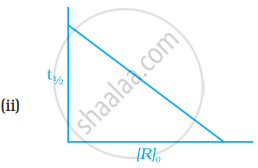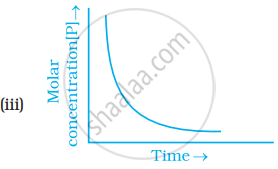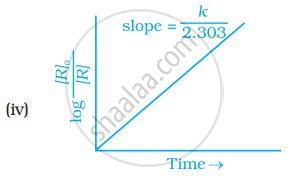Advertisements
Advertisements
प्रश्न
Which of the following graphs is correct for a first order reaction?




उत्तर


Explanation:
The pace of a reaction that is directly proportional to the concentration of the reacting substance is known as a first-order reaction.
A first-order reaction's kinetic equation
k = `2.303/t log [R]^0/([R])`
The Y-axis represents concentration, whereas the X-axis represents time.
`log = [R]^0/([R]) = (kt)/2.303`
`[log = [R]_0/([R])] = [(kt)/2.303](t)`
y = mn
k = `2.303/t log a/(a - x)`
t = `2.303/k log a/(a - x)`
x = `a - a/2`
x = `a/2`
`t_(1/2) = 2.303/k log a/(a - a/2)`
`2.303/k log 2`
`t_(1/2) = 0.693/k`
APPEARS IN
संबंधित प्रश्न
Sucrose decomposes in acid solution into glucose and fructose according to the first order rate law with `"t"_(1/2)`= 3 hours. What fraction of the sample of sucrose remains after 8 hours?
In a pseudo first order hydrolysis of ester in water, the following results were obtained:
| t/s | 0 | 30 | 60 | 90 |
| [A]/mol L−1 | 0.55 | 0.31 | 0.17 | 0.085 |
Calculate the average rate of reaction between the time interval 30 to 60 seconds.
The rate constant for a first order reaction is 60 s−1. How much time will it take to reduce the initial concentration of the reactant to its `1/16`th value?
For the decomposition of azoisopropane to hexane and nitrogen at 543 K, the following data are obtained.
| t (sec) | P(mm of Hg) |
| 0 | 35.0 |
| 360 | 54.0 |
| 720 | 63.0 |
Calculate the rate constant.
A first order reaction is 50% completed in 1.26 × 1014 s. How much time would it take for 100% completion?
A first order reaction is 50% complete in 20 minute What is rate constant?
In the first order reaction, half of the reaction is complete in 100 seconds. The time for 99% of the reaction to occurs will be
Gaseous cyclobutene isomerizes to butadiene in a first order process which has a 'k' value of 3.3 × 10−4 s−1 at 153°C. The time in minutes it takes for the isomerization to proceed 40% to completion at this temperature is ______. (Rounded-off to the nearest integer)
What is the rate constant?
Write the equation for integrated rate law for a first order reaction.
